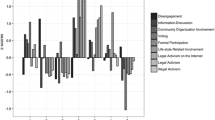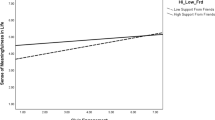Abstract
The aim of this study is to explore values, sense of coherence (SOC) as well as civic engagement, civic efficacy and hope among adolescents against the background of a social protest. We examined if a set of values and SOC explain civic engagement and civic efficacy. Furthermore, all of these variables were examined as explanatory factors of positive development examined by hope. Data were gathered among 400 adolescents aged 16–18 during a social protest. Adolescents filled out self-reported questionnaires which included socio-demographics characteristics; values, SOC, the youth social responsibility scale, civic efficacy and hope. Results show that all values and SOC explained civic engagement, while only universal and collective in-group values as well as civic engagement directly explained citizens’ efficacy. The model explained hope with 43 % of the variance. I discuss the direct and indirect relationship among the different variables and explain them in accord with positive development among youth.


Similar content being viewed by others
References
American Psychological Association. (1996). Contemporary psychology. APA Review of Books, 43, 372–374.
Anderson, M. R. (2010). Community psychology, political efficacy, and trust. Political Psychology, 31, 59–84. doi:10.1111/j.1467-9221.2009.00734.x.
Angvik, M., & Von Borries, B. (Eds.). (1997). Youth and history: A comparative European survey on historical consciousness and political attitudes among adolescents. Hamburg: Korber Foundation.
Antonovsky, A. (1979). Health, stress, and coping: New perspectives on mental and physical well-being (p. 1979). San Francisco: Jossey-Bass.
Antonovsky, A. (1987). Unraveling the mystery of health. San Francisco: Jossey-Bass.
Antonovsky, A. (1993). The structure and properties of the sense of coherence scale. Social Science & Medicine, 36(6), 725–733.
Arbuckle, J. L., & Wothke, W. (1999). Amos 4.0 user’s guide. Chicago, IL: Small Waters.
Bandura, A. (1977). Social learning theory. Upper Saddle River, NJ: Prentice Hall.
Bandura, A. (2001). Social cognitive theory: An agentic perspective. Annual Review of Psychology, 52, 1–26.
Bentler, P. (1990). Comparative fit indexes in structural models. Psychological Bulletin, 107(2), 238–246.
Bogy, T. F. M., Meeus, W. H. J., Raaijmakers, Q. A. W., & Vollebergh, W. A. M. (2001). Youth centrism and the formation of political orientation in adolescence and young adulthood. Journal of Cross-Cultural Psychology, 32, 229–240. doi:10.1177/0022022101032002009.
Bollen, K. (1989). Structural equations with latent variables. New York: Wiley.
Braun-Lewensohn, O., & Sagy, S. (2010). Sense of coherence, hope and values among adolescents under missile attacks: A longitudinal study. International Journal of Children’s Spirituality, 15(3), 247–260.
Breznitz, S. (1986). The effect of hope on coping with stress. In M. H. Appley & R. Trumbull (Eds.), Dynamics of stress: Physiological, psychological and social perspectives (pp. 295–306). New York: Plenum.
Browne, M. W., & Cudeck, R. (1993). Alternative ways of assessing model fit. In K. A. Bollen & J. S. Long (Eds.), Testing structural equation models (pp. 136–162). Newbury Park, CA: Sage.
Browning, C. R., Leventhal, T., & Brooks-Gunn, J. (2004). Neighborhood context and racial differences in early adolescent sexual activity. Demography, 41, 697–720. doi:10.1353/dem.2004.0029.
Campbell, D. (2006). Why we vote: How schools and communities shape our civic life. Princeton, NJ: Princeton University Press.
Carmines, E. G., & McIver, J. P. (1981). Analyzing models with unobserved variables. In G. W. Bohrnstedt & E. F. Borgatta (Eds.), Social measurement: Current issues. Beverly Hills, CA: Sage.
Celestin, L. P., & Celestin-Westreich, S. (2008). How to FACE polydrug use: Pathways toward an integrative structured care model to facilitate adjustment of cognitions and emotions. European Psychiatry, 23(2), S244–S245.
Clore, G. L., Schwarz, N., & Conway, M. (1994). Affective causes and consequences of social information processing. In R. S. Wyer Jr & T. K. Srull (Eds.), Handbook of social cognition (2nd ed., Vol. 1, pp. 323–417). Hillsdale, NJ: Lawrence Erlbaum.
Colby, A., & Damon, W. (1992). Some do care. New York: Free Press.
Feather, N. T. (1995). Values, valences and choice: The influence of values on the perceived attrativeness and chilce of alternatives. Journal of Personality and Social Psychology, 68, 1135–1151.
Feldman, D. B., & Snyder, C. R. (2005). Hope and the meaningful life: Theoretical and empirical associations between goal-directed thinking and life meaning. Journal of Social and Clinical Psychology, 24(3), 401–421.
Flanagan, C. A. (2003). Trust, identity, and civic hope. Applied Developmental Science, 7, 165–171.
Flanagan, C., Cumsille, P., Gill, S., & Gallay, L. (2007). School and community climates and civic commitments: Processes for ethnic minority and majority students. Journal of Educational Psychology, 99(2), 421–431. doi:10.1037/0022-0663.99.2.421.
Fromm, E. (1968). The revolution of hope. New York: Bantam.
Gecas, V. (2000). Value identities, self-motives, and social movements. In S. Styker, T. J. Owens, & R. W. White (Eds.), Self, identity and social movements (pp. 93–253). Minneapolis: University of Minnesota Press.
Gimpel, J., Lay, J. C., & Schuknecht, J. (2003). Cultivating democracy: Civic environmentsand political socialization in America. Washington, DC: BrookingsInstitution Press.
Gratevant, H. D., & Adams, G. R. (1984). Development of an objective measure to assess ego identity in adolescence: Validation and replication. Journal of Youth and Adolescence, 13, 419–438.
Hansen, D. M., Larson, R. W., & Dworkin, J. B. (2003). What adolescents learn in organized youth activities: A survey of self-reported developmental experiences. Journal of Research on Adolescence, 13(1), 25–55.
Haste, H. (2010). Citizenship education: A critical look at a contested field. In: Sherrod, L. R., Torney-Purta, J. & Flanagan, C.A. (Eds.), Handbook of research on civic engagement in youth (Ch. 7, pp. 161–188). New York: Wiley. doi:10.1002/9780470767603
Haste, H., & Hogan, A. (2006). Beyond conventional civic participation, beyond the moral-political divide: Young people and contemporary debates about citizenship. Journal of Moral Education, 35(4), 473–493.
Hitlin, S. (2003). Values as the core of personal identity: Drawing links between two theories of the self. Social Psychology Quarterly, 66, 118–137. http://www.jstor.org/stable/pdfplus/1519843.pdf
Hoyle, R. H. (1995). Structural equation modeling: Concepts, issues, and applications. Newbury Park, CA: Sage.
Isen, A. M. (1990). The influence of positive and negative affect on cognitive organization: Some implications for development. In N. L. Stein, B. Leventhal, & T. Trabasso (Eds.), Psychological and biological approaches to emotion (pp. 75–94). Hillsdale, NJ: Erlbaum.
Kagitcibasi, C. (1997). Individualism and collectivism. In J. W. Berry, M. H. Segall, & C. Kagitcibasi (Eds.), Handbook of cross cultural psychology (pp. 1–50). Boston: Ally & Bacon Publishers.
Lazarus, R. S. (1991). Emotion and adaptation. New York: Oxford University Press.
Ludden, A. B. (2011). Engagement in school and community civic activities among rural adolescents. Journal of Youth and Adolescence, 40, 1254–1270. doi:10.1007/s10964-010-9536-3.
Markstrom, C. A., Li, X., Blackshire, S. L., & Wilfong, J. J. (2005). Ego strength development of adolescents involved in adultsponsored structured activities. Journal of Youth and Adolescence, 34(2), 85–95.
Marzana, D., Marta, E., & Pozzi, M. (2011). Social action in young adults: Voluntary and political engagement. Journal of Adolescence,. doi:10.1016/j.adolescence.2011.08.013.
Metzger, A., & Smetana, J. G. (2009). Adolescent civic and political engagement: Associations between domain-specific judgments and behavior. Child Development, 80, 433–441.
Moorey, S., & Greer, S. (1989). Psychological therapy for patients with cancer: A new approach. London: Heneman.
Pancer, S. M., Pratt, M., Hunsberger, B., & Alisat, S. (2007). Community and political involvement in adolescence: What distinguishes the activists from the uninvolved? Journal of Community Psychology, 35, 741–759.
Raviv, A., Sade, A., Raviv, A., & Silberstein, O. (1998). The reaction of youth in Israel to the assassination of Prime Minister Yitzhak Rabin. Political Psychology, 19, 255–278.
Rohan, M. J. (2000). A rose by a name? The values construct. Personality and Social Psychology Review, 4, 255–277.
Sagy, S., & Adwan, S. (2006). Hope in times of threat: The case of Israeli and Palestinian youth. American Journal of Orthopsychiatry, 76, 128–133.
Sagy, S., Orr, E., & Bar-On, D. (1999). Individualism and collectivism in Israeli society: Comparing religious and secular high school students. Human Relations, 52, 327–348.
Sawatzky, R., Gadermann, A., & Pesut, B. (2009). An investigation of the relationships between spirituality, health status and quality of life in adolescents. Applied Research quality life, 4, 5–22.
Schulenberg, J., Bryant, A., & O’Malley, P. (2004). Taking hold of some kind of life: How developmental tasks relate to trajectories of well-being during the transition to adulthood. Development and Psychopathology, 16(4), 1119–1140.
Schwartz, S. H. (1992). Universals in the content and structure of values: Theoretical advances and empirical tests in 20 countries. Advances in Experimental Social Psychology, 25, 1–65.
Schwartz, S. H. (1995). Values. In A. S. R. Manstead & M. Hewstone (Eds.), The blackwell encyclopedia of social psychology (pp. 665–667). Oxford: Basil Blackwell.
Settle, J. E., Bond, R., & Levitt, J. (2011). The social origins of adult political behavior. American Politics Research, 39(2), 239–263. doi:10.1177/1532673X10382195.
Sharabi, A., Levi, U., & Margalit, M. (2012). Children’s loneliness, sense of coherence, family climate, and hope: Developmental risk and protective factors. The Journal of Psychology: Interdisciplinary and Applied, 146, 61–83. doi:10.1080/00223980.2011.568987.
Sherrod, L. R., Flanagan, C., & Youniss, J. (2002). Dimensions of citizenship and opportunities for youth development: The what, why, when, where, and who of citizenship development. Applied Developmental Science, 6, 264–272.
Snyder, C. R. (1994). Hope and optimism. Encyclopedia of Human Behavior, 2, 535–542.
Snyder, C. R. (2000). Hypothesis: There is hope. In C. R. Snyder (Ed.), Handbook of hope: Theory, measures, & applications (pp. 3–21). San Diego: Academic Press.
Snyder, M., & Omoto, A. (2007). Social action. In A. Kruglanski & E. T. Higgins (Eds.), Social psychology: a handbook of basic principles (2nd ed., pp. 940–961). New York: Guilford.
Staat, S. (1989). Hope: A comparison of two self report measures for adults. Journal of Personality Assessment, 53, 366–375.
Stewart, A., & McDermott, C. (2004). Civic engagement, political identity, and generation in developmental context. Research in Human Development, 1(3), 189–203.
Strang, S., & Strang, P. (2001). Spiritual thoughts, coping and ‘sense of coherence’ in brain tumour patients and their spouses. Palliative Medicine, 15, 127–134. doi:10.1191/026921601670322085.
Thoits, P. (1994). Stressors and problem solving: The individual as psychological activist. Journal of Health and Social Behavior, 35, 143–160.
Torney-Purta, J., Lehmann, R., Oswald, H., & Schulz, W. (2001). Citizenship and education intwenty-eight countries: Civic knowledge and engagement at age fourteen. Amsterdam: IEA.
Triandis, H. C., Bontempo, R., Marcelo, V. J., Masaaki, A., & Lucca, N. (1988). Individualism and collectivism: Cross-cultural perspectives on self-in-group relationships. Journal of Personality and Social Psychology, 54, 323–338.
Valentino, N. A., Gregorowicz, K., & Groenendyk, E. W. (2009). Efficacy, emotions and the habit of participation. Political Behavior, 31, 307–330. doi:10.1007/s11109-008-9076-7.
Watts, R. J., & Flanagan, C. (2007). Pushing the envelope on youth civic engagement: A developmental and liberation psychology perspective. Journal of Community Psychology, 35(6), 779–792.
Wray-Lake, L., & Syvertsen, A. K. (2011). The developmental roots of social responsibility in childhood and adolescence. In C. A. Flanagan & B. D. Christens (Eds.), Youth civic development: Work at the cutting edge (Vol. 134, pp. 11–25). New Directions for Child and Adolescent Development.
Youniss, J. (2006). Reshaping a developmental theory for political-civic development. In P. Levine & J. Youniss (Eds.), Youth civic engagement: An institutional turn. CIRCLE: Medford, MA.
Youniss, J., Bales, S., Christmas-Best, V., Diversi, M., McLaughlin, M., & Silbereisen, R. (2002). Youth civic engagement in the twenty first century. Journal of Research on Adolescence, 12, 121–148.
Youniss, J., McLellan, J., & Yates, M. (1997). What we know about engendering civic identity. American Behavioral Scientist, 40, 620–631.
Zaff, J. F., Kawashima-Ginsberg, K., Lin, E. S., Lamb, M., Balsano, A., & Lerner, R. M. (2011). Developmental trajectories of civic engagement across adolescence: Disaggregation of an integrated construct. Journal of Adolescence, 34, 1207–1220.
Author information
Authors and Affiliations
Corresponding author
Rights and permissions
About this article
Cite this article
Braun-Lewensohn, O. Sense of Coherence, Values, Youth Involvement, Civic Efficacy and Hope: Adolescents During Social Protest. Soc Indic Res 128, 661–673 (2016). https://doi.org/10.1007/s11205-015-1049-8
Accepted:
Published:
Issue Date:
DOI: https://doi.org/10.1007/s11205-015-1049-8




